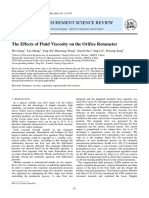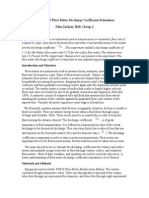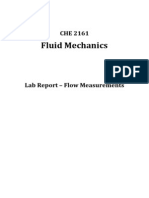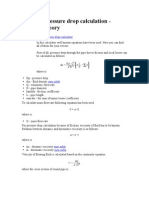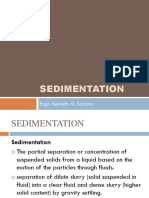Paul Ceglia Effects of Reynolds Number On Coriolis Flowmeters Paper PDF
Paul Ceglia Effects of Reynolds Number On Coriolis Flowmeters Paper PDF
Uploaded by
sengaigibonCopyright:
Available Formats
Paul Ceglia Effects of Reynolds Number On Coriolis Flowmeters Paper PDF
Paul Ceglia Effects of Reynolds Number On Coriolis Flowmeters Paper PDF
Uploaded by
sengaigibonOriginal Title
Copyright
Available Formats
Share this document
Did you find this document useful?
Is this content inappropriate?
Copyright:
Available Formats
Paul Ceglia Effects of Reynolds Number On Coriolis Flowmeters Paper PDF
Paul Ceglia Effects of Reynolds Number On Coriolis Flowmeters Paper PDF
Uploaded by
sengaigibonCopyright:
Available Formats
EFFECT OF REYNOLDS NUMBER IN CORIOLIS FLOW
MEASUREMENT
Christof Huber, Michael Nuber and Martin Anklin
Endress+Hauser Flowtec AG, Kgenstr. 7, 4153 Reinach, Switzerland
Abstract
In hydrocarbon measurement changing process conditions are the norm. Studies with highly
viscous fluids have indicated there may be a shift in the calibration factor of Coriolis mass
flow meter (CMF). According to those studies below a certain Reynolds (Re) number, the
meter reads below the actual mass flow. In highly viscous fluids its possible to achieve low
Re numbers with a sufficient mass flow.
As direct mass flow meters CMF are independent of the flow profile. Fluid structure
simulations show that the shift is caused by an oscillatory shear or viscous effect in the CMF
tubes due to the interaction between oscillating Coriolis forces and oscillating sheer forces.
The ratio of these two forces is reflected in the Re number of the flow. This is a strongly
deterministic effect only depending on the Re number.
Some CMF are able to measure the Re number. Subsequently a correction of the meter
factor on-line would be possible, giving even higher accuracy under harshest conditions.
This paper explains the mechanism behind this effect and presents data from different
Coriolis meters ranging from 3 up to 14 showing how to ensure highest accuracy and
repeatability for very low to high Re numbers. The importance of accuracy and repeatability
is tremendous considering the amount and cost of hydrocarbons flowing through pipes each
hour.
Introduction
When measuring hydrocarbon fluids strong variation of their properties namely density,
viscosity and compressibility may occur. This band-width of physical properties can
increase variations in the behaviour of the fluid flow in pipe lines. A Coriolis mass flow meter
should be able to compensate such changes in fluid-flow and consequently measure within
the accuracies as specified by the manufacturer.
Measurements data supporting a Reynolds number effect in Coriolis flow
meter
The effect mentioned above has not been widely observed in the field, yet there are studies
that imply it could also influence measurements by shifting the meter factor. TV/NEL
carried out independent tests using different Coriolis and Ultrasonic flow meters of various
manufacturers at temperatures between 10 and 40C on miscellaneous viscous test fluids
ranging from 1 to 300 cSt. The results published by Miller et al. in 2008 [1] showed under
readings of Coriolis meters when measuring with very high viscous fluids (Figure 1).
When looking at Figure 1 one might draw the conclusion that the particular Coriolis sensor is
not performing well for high viscous fluids, because the measurements show negative flow
rate errors and a nonlinear behavior with a poor repeatability over temperature. For the low
viscous fluids on the other hand the sensor measures within the stated performance. Similar
behavior was found for other types of CMF.
Figure 1: 4 Coriolis Meter measurements of the four different test fluids (Kerosine 1-3 cSt),
Gasoil (4-10 cSt), Velocite (10-30 cSt) and Primol (40-300 cSt) at temperatures between 10
and 40C. Plotted is the mass flow rate error against flow rate. Figure from Miller et al.
2008[1].
Kumar et al. [6-7] suggested a shift of meter factor as cause induced by the interaction
between oscillating Coriolis forces and oscillating sheer forces. The ratio of fluid dynamic
forces for an oscillating system, such as a CMF with viscous fluid flow, is mainly
characterized by a few dimensionless physical number e.g. Reynolds (Re) and Stokes (St)
numbers.
Hence, if the data from figure 1 are plotted against Reynolds number, as it has been done by
Mills, 2011 [2], the data look very deterministic (Figure 2). A shift in the meter reading with
decreasing Re number is observed indicating the presence of a fluid dynamic phenomenon
responsible behind the shift. The correlation of the measuring offset with the Re number
implies that if this CMF would process the Re number of every measuring point, it would be
possible to correct the negative offset of the calibration factor itself using a distinct
correction curve. The correction curve would solely be a function of the Re number.
Figure 2: Coriolis Meter mass flow error plotted against Reynolds number [Mills 2011]. A
shift in the meter reading with decreasing Reynolds number can be observed indicating the
presence of a fluid dynamic phenomenon responsible behind the shift.
Being aware of this situation, Coriolis meter manufacturers started to investigate the
observed effect. Experimental results support the findings from TV/NEL. Is there a way of
explaining the effect and can it be compensated? Conventional meters, such as turbine
meters, or advanced measurement principles, such as ultrasonic meters, are more
influenced by a change in Re number than Coriolis meters. [1, 10]
Understanding the mechanism
Experiments with different types of CMF featuring various designs and tube shapes with
highly viscous fluids seem to support the theory that there is a shift in the calibration factor
towards lower Re numbers. Further considerations suggest that this effect is not due to the
viscosity of the fluid itself, but with high viscous fluids it is possible to achieve low Reynolds
numbers with a moderate flow velocity. It should be noted that the shift is often wrongly
attributed to the change in flow-profile in the measuring line. However, it is important to
keep in mind a CMF, as a direct mass flow meter, is entirely independent of the nature of
axial flow profile in the measuring tube.
As far as Coriolis flow meters are concerned, there are a few attempts to simulate a CMF
using coupled fluidstructure interaction (FSI) approach. Kutin et al.[3-5] mainly investigated
flow profile effects in straight-tube Coriolis meters. According to their research the present
effect is due to the change in axial flow profile, because of the variation in the Reynolds
number. Kutin et al. [3-5] attributed the shift in meter readings with respect to decreasing
Re numbers to the change in axial flow profiles from turbulent to laminar transitions.
Kumar et al. [6] studied the mechanism which is behind this shift using the help of coupled
FSI simulations of real Coriolis meter designs and compared with the experimental data of
the same device. From Figure 3 it may be noticed that the numerical simulations
qualitatively support the experimental observations.
Figure 3: A comparison between experimental and numerical simulation results indicating a
shift in meter calibration factor in low Reynolds number region from [Kumar et al. 2010]
Kumar et al. [6-8] investigations suggest that the effect is the result of an interaction
between the oscillatory shear force and the inertial Coriolis force in the measuring tube,
leading to an oscillatory secondary flow. At a given time, this secondary flow moves in
opposite directions in either sides of the tube center and disappears at the center of the
-0.8
-0.6
-0.4
-0.2
0
0.2
0.4
0.6
0.8
100 1000 10000 100000 1000000
Re [ ]
d
e
v
i
a
t
i
o
n
[
%
]
FSI-simulations
experimental data
tube. The ratio of the two oscillating forces is directly proportional to the Re number of the
mean flow. The secondary flow at a Re number of 100 is shown in Figure 4a. At sufficiently
high Re number this secondary flow disappears and consequently the ratio of shear force to
Coriolis force becomes negligibly small.
(a) (b)
Figure 4: (a) The computed oscillatory secondary flow in moving-frame of reference at the
position where sensor is located, (b) a schematic representation of the oscillatory mechanism
responsible for Reynolds effect.
Since this effect of the secondary flow appears at the outer layer near the tube wall, it is
sometimes also called boundary layer effect. The phenomenon behind is briefly described
with the help of a schematic diagram in figure 4b. As shown there, the Coriolis force
interacting with the shear force induces an asymmetric force in the measuring tube. The
lower two panels illustrate that the Coriolis force induces a shear layer indicating a
secondary circulation in the cross-section of the measuring tube. The Coriolis force has to
overcome the shear force and part of the energy of the Coriolis force is dissipated in the
secondary circulation and does not contribute to the deflection of the tube. This explains
why the meter reading is below the actual mass flow. The magnitude of the secondary
circulation is strongly decreasing with higher Re numbers as the thickness of the shear-layer
decreases exponentially with the increasing Re number. Consequently, the effect becomes
insignificant above a certain Re number.
It is important not to confuse these oscillatory viscous or shear force with the steady shear
force exerted by the fluid on the pipe-wall. In a Coriolis meter, steady fluid-dynamic forces
cannot influence sensitivity of the meter. In order to influence the meter reading, the force
(e.g. viscous or shear force) has to be oscillating in nature and moreover the periodicity of
this force has to be matched with the periodicity of the pipe oscillations.
Real time correction for the Reynolds effect
In order to meet highest accuracy requirements in low-Re applications, the Re number
effect must be compensated.
The Re number is calculated as
D
m D V D V
4
Re (1)
where V is the mean flow velocity, the fluid density, Ddenotes the internal diameter of
the pipe
,
4 /
2
D
V
m the mass flow rate, the kinematic and the dynamic viscosity.
A CMF usually measures the mass flow rate and density. Therefore the only unknown
variable in eq. 1 is the viscosity which can be measured as well by some CMF [Rieder et. al 9]
Hence, if a Coriolis meter has the ability of deriving a measure for viscosity directly,
compensation can be done on-line by on-board means. However, this is a patented feature.
Measurements with different meters over a wide Reynolds number range
In the following figures witnessed measurements of Coriolis flow meter of the size 3, 4, 6,
10 and 14 are shown using on-line Re effect compensating. These measurements were
performed at TV/NEL (3-6) and SPSE (10-14), using different hydrocarbons ranging
from Kerosene over mineral and crude oils to heavy bunker fuels. Each meter was measured
over its whole flow range with at least two different fluids with strongly different viscosities.
The viscosity range reached from 0.7 up to more than 1000 cSt. By varying the flow rate and
the viscosity a huge Re number range from 100 up to 5,000,000 could be covered.
In figure 5 the measuring performance of the Coriolis meter is plotted against Re number. In
this plot no shift in the meter reading with decreasing Re number can be observed.
Figure 5: Coriolis Meter mass flow error of 5 different sizes plotted against Reynolds
number. Measurements were performed at TV/NEL (3 6) and SPSE (10 and 14).
Measuring performance is meeting accuracy requirements of OIML R117-1 class 0.3.
These measurements demonstrate that Coriolis devices are able to meet the accuracy
requirements of OIML R117-1 class 0.3 over a very wide range of fluids.
In figure 6 the same data is plotted against kinematic viscosity. In this figure no viscosity
effect can be observed.
Figure 6: Coriolis Meter mass flow error of 5 different sizes plotted kinematic viscosity.
Different hydrocarbons were measured ranging from naphtha and kerosene over crude oils to
heavy bunker fuels. Each meter was measured with at least two different liquids with strongly
distinct viscosities. The range of the viscosity reached from 0.7 up to more than 1000 cSt.
To sum up all of the above and give an indication about the abilities of the tested meters in
hydrocarbon measurement, figure 7 shows the relative mass flow error over the mass flow
rate. The measurement results bear testimony of the first-rate qualification and
measurement performance of CMF in hydrocarbon measurement.
Figure 7: Coriolis Meter mass flow error of 5 different sizes plotted against mass flow rate.
Each meter was measured over its whole flow range with at least two different liquids with
strongly distinct viscosities.
Conclusions
Although a Coriolis mass flow meter is independent of flow profile or installation effects,
studies suggested that it may be dependent on the Reynolds number of the mean flow.
With the help of fluid-structure interaction simulations, the mechanism responsible for the
Reynolds effect in CMFs can be elucidated. It has been shown that the Reynolds effect may
induce a secondary flow in the oscillating tubes of CMF. The oscillatory secondary flow
would lead to a change in the sensitivity of the flow meter. The meter deviation can be
corrected in-line in the flow meter provided the mass flow and viscosity are known.
Aknowledgements
The authors would like to acknowledge the help of Dirk Butzbach, Marcel Braun and Tony
Leenhoven which all contributed by achieving the measuring data used in this paper, as well
as Paul Ceglia. The authors would also like to thank TV/NEL for providing the original
measurement data depicted in figure 1.
References
[1] G. Miller and B. Belshaw. An investigation into the performance of Coriolis and ultrasonic
meters at liquid viscosities up to 300 cSt. 26
th
International North Sea Flow Measurement
Workshop, 2008
[2] C. Mills, Coriolis questions, Technical Issues, www.bunkerspot.com, 2011
[3] G. Bobovnik, J. Kutin and I. Bajsic, The effect of flow conditions on the sensitivity of the
Coriolis flowmeter. Flow Measurement and Instrumentation, 15:69-76, 2004
[4] J. Kutin, J. Hemp, G. Bobovnik and I. Bajsic, Weight vector study of velocity profile effects in
straight-tube Coriolis flow meters employing different circumferential modes. Flow
Measurement and Instrumentation, 16:375385, 2005
[5] J. Kutin, G. Bobovnik, J. Hemp and I. Bajsic, Velocity profile effects in Coriolis mass flow
meters: Recent findings and open questions. Flow Measurement and Instrumentation,
17:349358, 2006
[6] V. Kumar, M. Anklin and B. Schwenter, Fluid-structure interaction (FSI) simulations on the
sensitivity of coriolis flow meter under low Reynolds number flows, 15
th
Flow Measurement
Conference (FLOMEKO), Taipei, Taiwan, 2010
[7] V. Kumar, P. Tschabold, M. Anklin, Influence and Compensation of Process Parameters on
Coriolis Meters with a View to Custody Transfer of Hydrocarbon Products, TV/NEL 9
th
South
East Asia Hydrocarbon Flow Measurement Workshop, 2010
[8] V. Kumar and M. Anklin, Numerical simulations of Coriolis flow meters for low Reynolds
number flows, MAPAN Journal of Metrology Society of India, Vol. 26, No. 3, pp. 225-235,
2011
[9] A. Rieder, Coriolis Mass Flow Meter with Direct Viscosity Measurement, Pumps and
Compressors with Compressed Air and Vacuum Technology, 52-55, 201
[10] A. Ranseth, Reynolds Number Calibration of Turbine Meters, Operating Section Proceedings,
American Gas Association 2; 738-743, 2006
You might also like
- Pipe Friction Lab ReportDocument13 pagesPipe Friction Lab Reportharrov455% (11)
- Beggs and Brill MethodDocument26 pagesBeggs and Brill MethodHassanKMNo ratings yet
- CARRIER Duct DesignDocument16 pagesCARRIER Duct DesignBudiman Raharjo'bjo'82% (17)
- Garcia and Avesani Neto 2021 - Stress-Dependent Method For Calculating The Modulus Improvement Factor in Geocell-Reinforced Soil LayersDocument13 pagesGarcia and Avesani Neto 2021 - Stress-Dependent Method For Calculating The Modulus Improvement Factor in Geocell-Reinforced Soil LayersPARCOR S.A.S.0% (1)
- Technical Paper - Reynolds Number Based ProvingDocument11 pagesTechnical Paper - Reynolds Number Based ProvingCLNo ratings yet
- MEC2404 Frictional Flow in Pipe Lab RepoDocument10 pagesMEC2404 Frictional Flow in Pipe Lab Repoatik100% (1)
- 2016 12 Reynolds Number The Correct Calibration Characterization and Proving of Flow Meters Cousins CEESIDocument13 pages2016 12 Reynolds Number The Correct Calibration Characterization and Proving of Flow Meters Cousins CEESIqmet.solNo ratings yet
- RotametreDocument9 pagesRotametreJohn AdewaleNo ratings yet
- Improvementsin CoriolisflowmeasurementtechnologyDocument8 pagesImprovementsin CoriolisflowmeasurementtechnologyfabiouverneyNo ratings yet
- Viscosity Measuring of Non Newtonian FluidsDocument3 pagesViscosity Measuring of Non Newtonian Fluidscoolfire_aliNo ratings yet
- Calcul MicrohidropowerDocument35 pagesCalcul Microhidropowermoraru_coriolanNo ratings yet
- Lesson 5Document39 pagesLesson 5Marx VillanuevaNo ratings yet
- Ultrasonic CalibrationDocument24 pagesUltrasonic CalibrationairsnowNo ratings yet
- Theoretical Uncertainty of Orifice Flow Measurement 172KBDocument7 pagesTheoretical Uncertainty of Orifice Flow Measurement 172KBSatya Sai Babu YeletiNo ratings yet
- Theoretical Uncertainty of Orifice Flow Measurement TechWpaperDocument8 pagesTheoretical Uncertainty of Orifice Flow Measurement TechWpaperFikri AchdanNo ratings yet
- Experiment 1 Fluid Flow Regime (Reynolds Number Apparatus) : Gaspar, Rickie Mae S. Group 3Document4 pagesExperiment 1 Fluid Flow Regime (Reynolds Number Apparatus) : Gaspar, Rickie Mae S. Group 3rickiegasparNo ratings yet
- Energy Loss in PipesDocument8 pagesEnergy Loss in PipesRo Win83% (6)
- Reynolds NumberDocument11 pagesReynolds NumberNur Falini Mohd Sukkri98% (51)
- Huon Croll Solar Pump Experiment 2 Group 206 5995324 1239563971Document10 pagesHuon Croll Solar Pump Experiment 2 Group 206 5995324 1239563971huonpatrickcrollNo ratings yet
- Bsen 3310 Flow Meter Discharge Coefficient EstimationDocument7 pagesBsen 3310 Flow Meter Discharge Coefficient Estimationapi-300980681No ratings yet
- Pierderi in ConducteDocument8 pagesPierderi in ConducteElena ConstantinNo ratings yet
- Agitation of Non-Newtonian FluidsDocument8 pagesAgitation of Non-Newtonian FluidsandresjypNo ratings yet
- Pressure Drop CalculationDocument8 pagesPressure Drop CalculationDavid Lambert100% (1)
- Convection Heat Transfer in Micro-ChannelsDocument50 pagesConvection Heat Transfer in Micro-ChannelsBehzad Mohajer100% (1)
- ABB-733-WPO Understanding Coriolis Mass FlowmeterDocument3 pagesABB-733-WPO Understanding Coriolis Mass FlowmetercarlosmandopintoNo ratings yet
- Fric Flow Ours FINAL VR 2Document14 pagesFric Flow Ours FINAL VR 2Edwin Jesu DassNo ratings yet
- ME - 233: Fluid Mechanics - II: Dr. Emad UddinDocument23 pagesME - 233: Fluid Mechanics - II: Dr. Emad UddinTalha MohsinNo ratings yet
- Experiment 5: Flow Through Packed BedsDocument5 pagesExperiment 5: Flow Through Packed BedsBianca BelmonteNo ratings yet
- Improving Turbine Meter Measurement by Alternate Fluid Calibration PDFDocument11 pagesImproving Turbine Meter Measurement by Alternate Fluid Calibration PDFcsierracdtNo ratings yet
- Lab Experiment 3 - Flow Through PipesDocument8 pagesLab Experiment 3 - Flow Through PipesLance HernandezNo ratings yet
- Flow Over A CylinderDocument15 pagesFlow Over A CylinderRicardo LopesNo ratings yet
- HMT216B LAB REPORT (Final)Document22 pagesHMT216B LAB REPORT (Final)Solethu MthembuNo ratings yet
- CHE 217 Lab 4Document10 pagesCHE 217 Lab 4igor_silva02No ratings yet
- Choice of Pipelines For The Transport of Hydrocarbons: Pipeline Flow Aspects (Document3 pagesChoice of Pipelines For The Transport of Hydrocarbons: Pipeline Flow Aspects (Guillermo ToledoNo ratings yet
- Lab Report TemplateDocument3 pagesLab Report Templatemobinarafiee2018No ratings yet
- Reynolds Number and Impeller Diameter Effects On Instabilities in Stirred VesselsDocument14 pagesReynolds Number and Impeller Diameter Effects On Instabilities in Stirred Vesselsade azmiNo ratings yet
- Perturbation-Based Prediction of Vibration Phase Shift Along Fluid-Conveying Pipes Due To Coriolis Forces, Nonuniformity, and NonlinearityDocument27 pagesPerturbation-Based Prediction of Vibration Phase Shift Along Fluid-Conveying Pipes Due To Coriolis Forces, Nonuniformity, and Nonlinearityalikiani1379.akNo ratings yet
- Compressible Effects Modelling in Turbulent Cavitating p.8 p.18Document85 pagesCompressible Effects Modelling in Turbulent Cavitating p.8 p.18劉平本No ratings yet
- Disper - Sion Phenomena in High Viscosity Immiscible Fluid Systems and Application of Static Mixers As Dispersion Devices in Such SystemsDocument53 pagesDisper - Sion Phenomena in High Viscosity Immiscible Fluid Systems and Application of Static Mixers As Dispersion Devices in Such SystemsRayito HernándezNo ratings yet
- Flow MeasurementDocument10 pagesFlow Measurementiroshauk67% (3)
- Discharge Coefficient Performance of Venturi, Standard Concentric Orifice Plate Vcone and Wedge Flow Meters at Low Reynolds NumbersDocument8 pagesDischarge Coefficient Performance of Venturi, Standard Concentric Orifice Plate Vcone and Wedge Flow Meters at Low Reynolds NumbersmaylabinotiNo ratings yet
- Reynolds Numbers ExperimentDocument7 pagesReynolds Numbers ExperimentSufferedMuch100% (3)
- CFD PDFDocument15 pagesCFD PDFShimal De SilvaNo ratings yet
- Fully Developed Viscous in Coiled Circular Pipes: Larry Austin and J.D. SeaderDocument10 pagesFully Developed Viscous in Coiled Circular Pipes: Larry Austin and J.D. SeaderMaiman LatoNo ratings yet
- Coriolis Flow MeasurementDocument19 pagesCoriolis Flow MeasurementtetiospamNo ratings yet
- 417-Final Thesis Ater Plg. Check-1Document44 pages417-Final Thesis Ater Plg. Check-1balaji.sasane99No ratings yet
- Fundamentals of Flow MeteringDocument12 pagesFundamentals of Flow Meteringadlalbi100% (1)
- Pressure Drop CalculationDocument8 pagesPressure Drop Calculationmazumdar_satyajit100% (1)
- Medidores de FlujoDocument6 pagesMedidores de FlujoJosé gonzálezNo ratings yet
- 1207 FWRJ Tech3Document3 pages1207 FWRJ Tech3ceice2013No ratings yet
- Flow Meter TypesDocument11 pagesFlow Meter TypesFaisal Rafique100% (1)
- Flow Meter & Its TypesDocument32 pagesFlow Meter & Its TypesAmmar MohsinNo ratings yet
- A Review On Turbulent Flow Through Pipe A State of Art IJERTCONV3IS20094Document4 pagesA Review On Turbulent Flow Through Pipe A State of Art IJERTCONV3IS20094newworldosemwegieNo ratings yet
- Final ReportDocument26 pagesFinal Reportapi-461820735No ratings yet
- Flow GuideDocument5 pagesFlow GuideKHairil AdZharNo ratings yet
- Hydraulic Tables; The Elements Of Gagings And The Friction Of Water Flowing In Pipes, Aqueducts, Sewers, Etc., As Determined By The Hazen And Williams Formula And The Flow Of Water Over The Sharp-Edged And Irregular Weirs, And The Quantity DischargedFrom EverandHydraulic Tables; The Elements Of Gagings And The Friction Of Water Flowing In Pipes, Aqueducts, Sewers, Etc., As Determined By The Hazen And Williams Formula And The Flow Of Water Over The Sharp-Edged And Irregular Weirs, And The Quantity DischargedNo ratings yet
- Analysis and Design of Multicell DC/DC Converters Using Vectorized ModelsFrom EverandAnalysis and Design of Multicell DC/DC Converters Using Vectorized ModelsNo ratings yet
- Introductory Laplace Transform with ApplicationsFrom EverandIntroductory Laplace Transform with ApplicationsRating: 5 out of 5 stars5/5 (1)
- Fluid Mechanics in Channel, Pipe and Aerodynamic Design Geometries 2From EverandFluid Mechanics in Channel, Pipe and Aerodynamic Design Geometries 2No ratings yet
- Archimedes PDFDocument12 pagesArchimedes PDFAliyahMohdNoor100% (2)
- EN1993 Practice Paper-Buckling Analysis of Steel BridgesDocument16 pagesEN1993 Practice Paper-Buckling Analysis of Steel BridgesaktcNo ratings yet
- June 2021 (v1) MS - Paper 4 CIE Physics IGCSEDocument11 pagesJune 2021 (v1) MS - Paper 4 CIE Physics IGCSEManya PunjabiNo ratings yet
- Physics Laboratory Activity 3: Free FallDocument4 pagesPhysics Laboratory Activity 3: Free FallGisella F. VelascoNo ratings yet
- Iwa282 Lab 4Document23 pagesIwa282 Lab 4Lp NgNo ratings yet
- Newton's Laws of Motion: Dr. Loai AfanaDocument22 pagesNewton's Laws of Motion: Dr. Loai AfanaRaghda JoudaNo ratings yet
- Explain in Your Own Words What Heat Is and Explain The Difference Between Heat and EnergyDocument1 pageExplain in Your Own Words What Heat Is and Explain The Difference Between Heat and EnergypashupatishahNo ratings yet
- Important FMDocument12 pagesImportant FMVijay VijayNo ratings yet
- Useful Reference Mass, Volume and FlowDocument3 pagesUseful Reference Mass, Volume and FlowAshok BaldaniyaNo ratings yet
- 11 Dynamics-Ramps and InclinesDocument2 pages11 Dynamics-Ramps and InclineseltytanNo ratings yet
- ENGINEERING FIELD MANUAL - Chapter 3Document116 pagesENGINEERING FIELD MANUAL - Chapter 3Vicio SammartanoNo ratings yet
- Flight MechanicsDocument3 pagesFlight MechanicsQwer QwerNo ratings yet
- 1 PB PDFDocument9 pages1 PB PDFDIEGO ALEJANDRO PARRA GARRIDONo ratings yet
- Residual Stresses in Injection Molded ProductsDocument8 pagesResidual Stresses in Injection Molded ProductsArjav ThakkarNo ratings yet
- Extra Notes On "Physical Quantities & Units"Document2 pagesExtra Notes On "Physical Quantities & Units"Amira Farahin100% (1)
- SEDIMENTATION PresentationDocument45 pagesSEDIMENTATION PresentationShai Sta CatalinaNo ratings yet
- Ae Unit 6Document9 pagesAe Unit 6Praveen RathodNo ratings yet
- 1 Exercise 20.3b PG 777: GivenDocument10 pages1 Exercise 20.3b PG 777: Givensuhanizah suhanizahNo ratings yet
- Effect of Water Depth On Added MassDocument17 pagesEffect of Water Depth On Added MassPraveen BalasubramanianNo ratings yet
- Homework III - Chapter 5: Problem 1Document4 pagesHomework III - Chapter 5: Problem 1Andres CondoriNo ratings yet
- 3-5 Commutation Relation of Angular MomentumDocument7 pages3-5 Commutation Relation of Angular MomentumM SHOAIB KHALIDNo ratings yet
- Unit 4 (Reaction Turbines.) 1Document12 pagesUnit 4 (Reaction Turbines.) 1amarparimiNo ratings yet
- Lecture notes-AIRCRAFT STRUCTURES-introductionDocument23 pagesLecture notes-AIRCRAFT STRUCTURES-introductionTarik Hassan ElsonniNo ratings yet
- TurboExpander CalculationsDocument7 pagesTurboExpander Calculationsvkumaran100% (1)
- (Graduate Texts in Physics) Peter Hertel-Quantum Theory and Statistical Thermodynamics - Principles and Worked Examples-Hertel, Peter, Springer Verlag (2017)Document382 pages(Graduate Texts in Physics) Peter Hertel-Quantum Theory and Statistical Thermodynamics - Principles and Worked Examples-Hertel, Peter, Springer Verlag (2017)Alex Samuel Silva100% (1)
- Conductor GallopingDocument21 pagesConductor GallopingRoberto savaNo ratings yet
- SI. No. Page No.: Uniform Flow in Open ChannelDocument163 pagesSI. No. Page No.: Uniform Flow in Open ChannelsatydevsinghnegiNo ratings yet
- Padeye Design CheekDocument3 pagesPadeye Design CheekBolarinwa89% (9)








